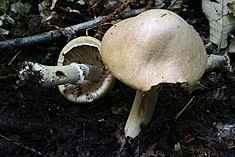Cortinarius caperatus
| Cortinarius caperatus | |
|---|---|
 |
|
| Scientific classification | |
| Kingdom: | Fungi |
| Division: | Basidiomycota |
| Class: | Agaricomycetes |
| Order: | Agaricales |
| Family: | Cortinariaceae |
| Genus: | Cortinarius |
| Species: | C. caperatus |
| Binomial name | |
|
Cortinarius caperatus (Pers.) Fr. (1838) |
|
| Synonyms | |
|
Rozites caperata (Pers.) P. Karst. |
|
| Cortinarius caperatus | |
|---|---|
| Mycological characteristics | |
| gills on hymenium | |
|
|
cap is convex or umbonate |
| hymenium is adnate | |
| stipe has a ring | |
|
|
spore print is ochre to brown |
| ecology is mycorrhizal | |
| edibility: edible | |
Rozites caperata (Pers.) P. Karst.
Pholiota caperata (Pers.) Gillet
Dryophila caperata (Pers.) Quél.
Togaria caperata (Pers.) W.G. Sm.
cap is convex
spore print is ochre
Cortinarius caperatus, commonly known as the gypsy mushroom, is a highly esteemed edible mushroom of the genus Cortinarius found in northern regions of Europe and North America. It was known as Rozites caperata for many years, before genetic studies revealed it lay within the large genus Cortinarius. The ochre-coloured fruiting bodies appear in autumn in coniferous and beech woods, as well as heathlands in late summer and autumn. The gills are free and clay-coloured and the smell and taste mild. Although mild-tasting and highly regarded, the gypsy mushroom is often infested with maggots.
The gypsy mushroom has a checkered taxonomic history. It was originally described as Agaricus caperatus in 1796 by mycologist Christian Hendrik Persoon, who noted it grew in beech woods. The specific epithet caperatus is Latin for “wrinkled”. It was transferred to the genus Cortinarius by the Swedish mycologist Elias Magnus Fries. Later it was transferred to Pholiota in 1874 by Claude Casimir Gillet. This was followed by Pier Andrea Saccardo. The genus Rozites (after mycologist Ernst Roze) was established by Finnish mycologist Petter Adolf Karsten in 1879 to accommodate the species on the basis of the mushroom having a double veil, and it was known as Rozites caperata (Pers.) P. Karst. for many years. The variant Rozites caperatus was and is also sometimes seen, but this may be a mistake.
...
Wikipedia
